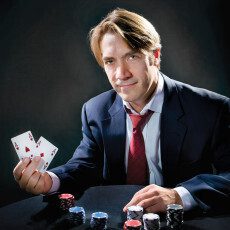- February 06, 2014
- By Brittany Kyser
Finance Professor Steven Heston ’83 is well known for his formula that gives the value of an option when a stock’s risk fluctuates randomly. But Heston, whose experience includes faculty positions at Yale and Columbia and private-sector jobs with Goldman Sachs, is better known in some circles for a series of books applying game theory to no-limit Texas hold ’em poker. Initially published under the pseudonym Kim Lee (until Heston got tenure), the “Kill Phil” booksoutline a strategy to beat professional players like Phil Hellmuth. Heston donates all royalties to an orphanage in Haiti.
Q: How does a finance professor get involved in writing books about poker theory?
A: My co-authors, Lee Nelson and Blair Rodman, sought me out to develop simplified computer-based strategies. I explained that equilibrium calculations would be computationally infeasible because we don’t know the opponents’ strategy. My co-authors, who earn their living playing poker, told me, ‘We actually do know the rough strategies our opponents use!’ That real-world poker knowledge made it possible. I got involved for the fun and intellectual challenge.
Q: Can you explain your basic poker theory?
A: In order to fit into a book, the strategy is simplified to go all-in or fold every hand. We analyzed all possible head-to-head hand matchups on a 169 by 169 grid (169 represents all possible two-card combinations vs. 169 possible combinations of an opponent’s hand). Going all in may seem risky, but sometimes the biggest risk is not taking one at all. An advantage of this all-or-nothing strategy for a beginner is that it intimidates other players and neutralizes the professional player’s skill advantage. It’s like challenging a martial arts expert to a duel at two paces with hand grenades.
Q: If you had $10,000 to invest, would you invest in the options market based on the heston model or in a poker tournament, based on your math-based poker strategies?
A: (Laughs) It’s hard to make money without risk. Financial markets are very efficient, and my option formula is widely available to option traders through Bloomberg systems. Similarly, the higher levels of poker have adapted to published strategies. Like most people who are smart enough to beat poker, I can make more money doing other things.
Q: Do you use poker strategies to teach your students finance?
A: Not specifically, but there are lessons we can learn from poker. A friend of mine was sometimes staked by other players. When he was playing with other people’s money, he played looser and took more risks than he would take with his own money. This resembles what happened in the housing market collapse. With the U.S. government implicitly insuring losses on “too big to fail” institutions, banks were encouraged to make riskier loans, until it all fell apart. When losses are subsidized, people just pay too little heed to risk. Options and poker theory are fun because they prove that math works in the real world.
Watch Anthony Curtis, publisher of the three “Kill Phil” books, incorrectly apply Heston’s “all-in” theory against poker pro Sammy Farha, with disastrous results:
